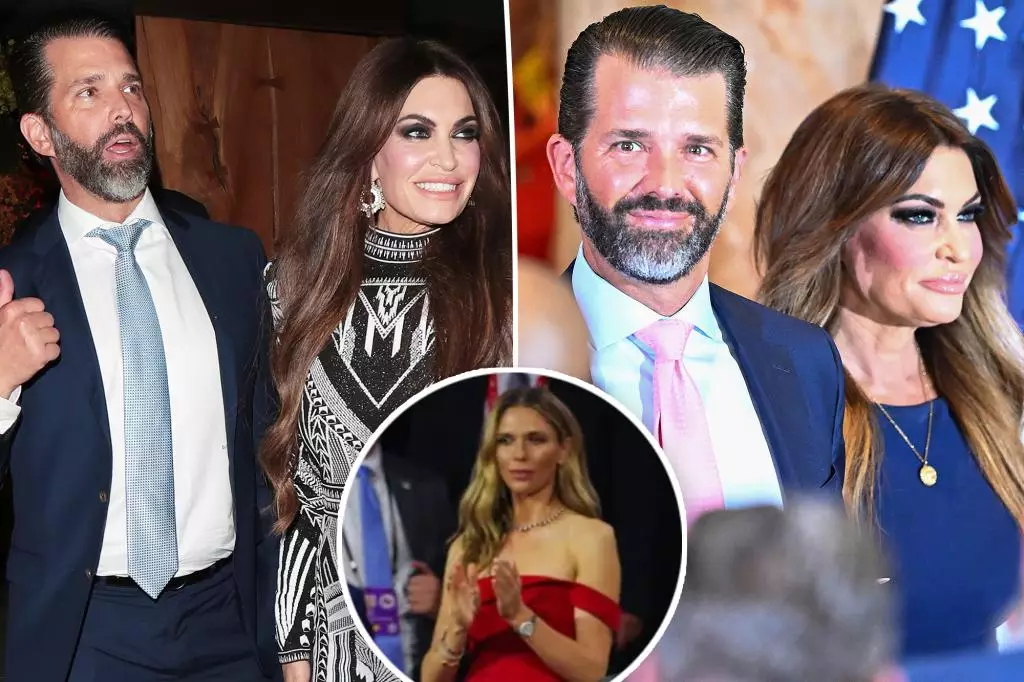In the glitzy world of political ambition and socialite escapades, the recent Republican National Convention in Milwaukee, Wisconsin, provided fertile ground for rumors and glimpses of intrigue. This year’s convention saw not only political heavyweights but also notable figures from the social scene mingling amongst the crowd. One such figure was Bettina Anderson, a socialite who found herself in the midst of speculation regarding her connections to Donald Trump Jr. and his fiancée, Kimberly Guilfoyle. The drama surrounding this trio has sparked discussions that reach far beyond the confines of the convention center itself.
Reports have surfaced detailing a series of interactions between Anderson and Trump Jr. that have not gone unnoticed. The Daily Mail highlighted an incident where the two were seen sharing intimate moments at a brunch in Palm Beach, igniting chatter about the state of Don Jr. and Kimberly’s relationship. While the public and media have observed Anderson and Trump Jr.’s reciprocated affection, insiders find themselves divided: Are they simply good friends, or has a romantic linkage begun to blossom?
As the specter of infidelity looms, insiders maintain the narrative that the connection is merely platonic. However, the daily happenings at the convention suggested otherwise. Anderson’s presence sitting directly behind the couple at the convention, decked in red and exuding charm, only served to intensify the rumors. Can one dismiss the optics of her flanking the celebrated couple of the evening? It seems unlikely, as much of the public eye was drawn to what appeared to be a rift just beneath the surface of Don Jr.’s well-documented public life.
At the heart of this narrative lies the unsteady state of Don Jr. and Kimberly’s relationship. Sources, cloaked in anonymity, have reported varying accounts of the couple’s dynamic over the past year. Some insiders have suggested that bickering has become commonplace, with tension escalating during public appearances at Mar-a-Lago. Yet, conflicting accounts emerge, painting a picture of a couple still very much united in their public endeavors. As Don Jr. and Kimberly prepare for a youth conference in Texas, the question remains: is their relationship on stable ground, or are interference and rumors leading them astray?
This duality speaks to the broader theme of the socialite influence and media scrutiny faced by public figures today. Inevitably, relationships are dissected and analyzed under the harsh spotlight of public opinion, often leading to sensational stories that might not tell the full truth. Anderson’s newfound popularity among Trump enthusiasts, especially given her recent Instagram postings promoting pro-Trump sentiments, further complicates the narrative surrounding her motives and allegiances.
In an age dominated by social media and constant connectivity, the unfolding stories surrounding the relationships in the Trump family exemplify how quickly narratives can shift. Anderson’s social media presence—a playful blend of philosophical musings and references drawn from pop culture—offers a glimpse into her psyche, serving both to bolster her image and to challenge the narratives being spun by gossip columns. The ‘devil’s telephone’ quote attributed to Moira Rose, along with imagery hinting at intimacy with Trump Jr., serves to provoke curiosity and conjecture from the audience.
While Anderson may have initially seemed a mere footnote in the Trump saga, her presence at high-profile events has transitioned her into the main storyline. The public’s reaction to each development has become a reflection of their own feelings about the Trump family and the broader polarizing political landscape. As narratives weave through personal lives, they often portray larger societal sentiments, thereby positioning individuals as symbols of broader ideologies.
The stakes rise even higher when considering the potential ramifications of relationship dynamics within this golden sphere of influence. For Kimberly Guilfoyle, who has been prominently entrenched in the conservative movement and positioned as a staple of Trump events, the implications of Anderson’s dalliance—or appearance of such—could spell trouble. As GOP insiders operate under the premise that the Trump family is closely knit, any hint of discord could be viewed as a direct affront to the familial image they work hard to project.
As the public watches and waits for the next chapter in this social soap opera, it becomes clearer that relationships among public figures—and those who orbit them—are rarely straightforward. The swirling narratives, revealing glimpses of intimacy, friendship, and potential betrayals serve not only as entertainment but also as a reminder of the societal fascination with the disasters and dramas that play out under the glitzy veneer of political life. The intersection of glamour, politics, and personal relationships continues to draw intrigue, proving that in today’s world, no connection is immune to scrutiny.

Leave a Reply